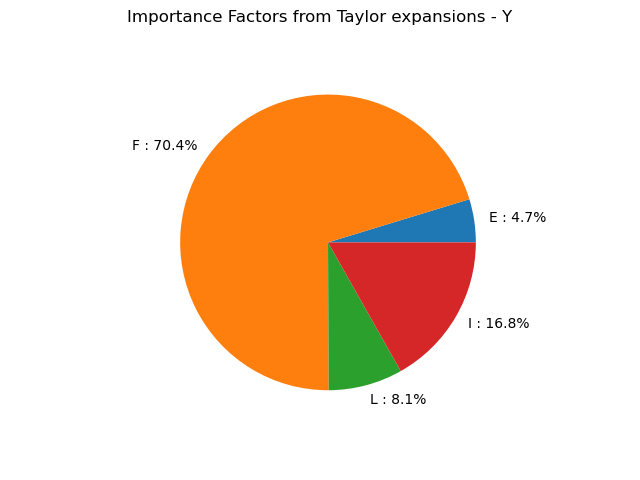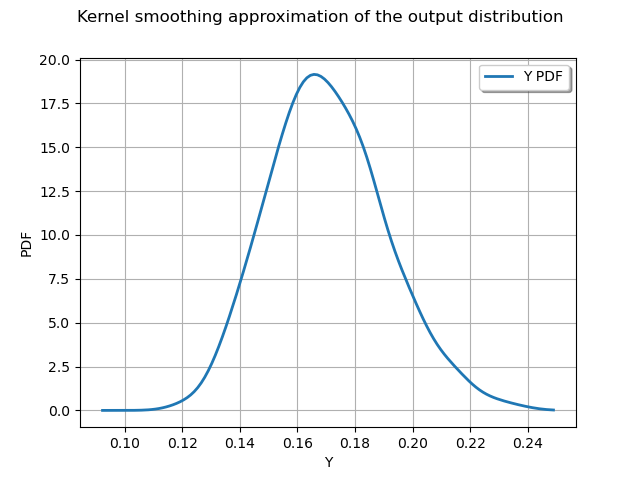Note
Go to the end to download the full example code
Analyse the central tendency of a cantilever beam¶
In this example we perform a central tendency analysis of a random variable Y using the various methods available. We consider the cantilever beam example and show how to use the TaylorExpansionMoments and ExpectationSimulationAlgorithm classes.
from openturns.usecases import cantilever_beam
import openturns as ot
import openturns.viewer as viewer
from matplotlib import pylab as plt
ot.Log.Show(ot.Log.NONE)
We first load the data class from the usecases module :
cb = cantilever_beam.CantileverBeam()
We want to create the random variable of interest where
is the physical model and
is the input vectors.
We create the input parameters distribution and make a random vector. For the sake of this example, we consider an independent copula.
distribution = ot.ComposedDistribution([cb.E, cb.F, cb.L, cb.II])
X = ot.RandomVector(distribution)
X.setDescription(["E", "F", "L", "I"])
f is the cantilever beam model :
f = cb.model
The random variable of interest Y is then
Y = ot.CompositeRandomVector(f, X)
Y.setDescription("Y")
Taylor expansion¶
Perform Taylor approximation to get the expected value of Y and the importance factors.
taylor = ot.TaylorExpansionMoments(Y)
taylor_mean_fo = taylor.getMeanFirstOrder()
taylor_mean_so = taylor.getMeanSecondOrder()
taylor_cov = taylor.getCovariance()
taylor_if = taylor.getImportanceFactors()
print("model evaluation calls number=", f.getGradientCallsNumber())
print("model gradient calls number=", f.getGradientCallsNumber())
print("model hessian calls number=", f.getHessianCallsNumber())
print("taylor mean first order=", taylor_mean_fo)
print("taylor variance=", taylor_cov)
print("taylor importance factors=", taylor_if)
model evaluation calls number= 1
model gradient calls number= 1
model hessian calls number= 1
taylor mean first order= [0.170111]
taylor variance= [[ 0.00041128 ]]
taylor importance factors= [E : 0.0471628, F : 0.703601, L : 0.0811537, I : 0.168082]
graph = taylor.drawImportanceFactors()
view = viewer.View(graph)

We see that, at first order, the variable explains about 70% of the variance of the output
.
On the other hand, the variable
is the least significant in the variance of the output:
only explains about 5% of the output variance.
Monte-Carlo simulation¶
Perform a Monte Carlo simulation of Y to estimate its mean.
algo = ot.ExpectationSimulationAlgorithm(Y)
algo.setMaximumOuterSampling(1000)
algo.setCoefficientOfVariationCriterionType("NONE")
algo.run()
print("model evaluation calls number=", f.getEvaluationCallsNumber())
expectation_result = algo.getResult()
expectation_mean = expectation_result.getExpectationEstimate()
print(
"monte carlo mean=",
expectation_mean,
"var=",
expectation_result.getVarianceEstimate(),
)
model evaluation calls number= 1001
monte carlo mean= [0.169423] var= [3.97818e-07]
Central dispersion analysis based on a sample¶
Directly compute statistical moments based on a sample of Y. Sometimes the probabilistic model is not available and the study needs to start from the data.
Y_s = Y.getSample(1000)
y_mean = Y_s.computeMean()
y_stddev = Y_s.computeStandardDeviation()
y_quantile_95p = Y_s.computeQuantilePerComponent(0.95)
print("mean=", y_mean, "stddev=", y_stddev, "quantile@95%", y_quantile_95p)
mean= [0.170554] stddev= [0.0201377] quantile@95% [0.205774]
graph = ot.KernelSmoothing().build(Y_s).drawPDF()
graph.setTitle("Kernel smoothing approximation of the output distribution")
view = viewer.View(graph)
plt.show()

 OpenTURNS
OpenTURNS